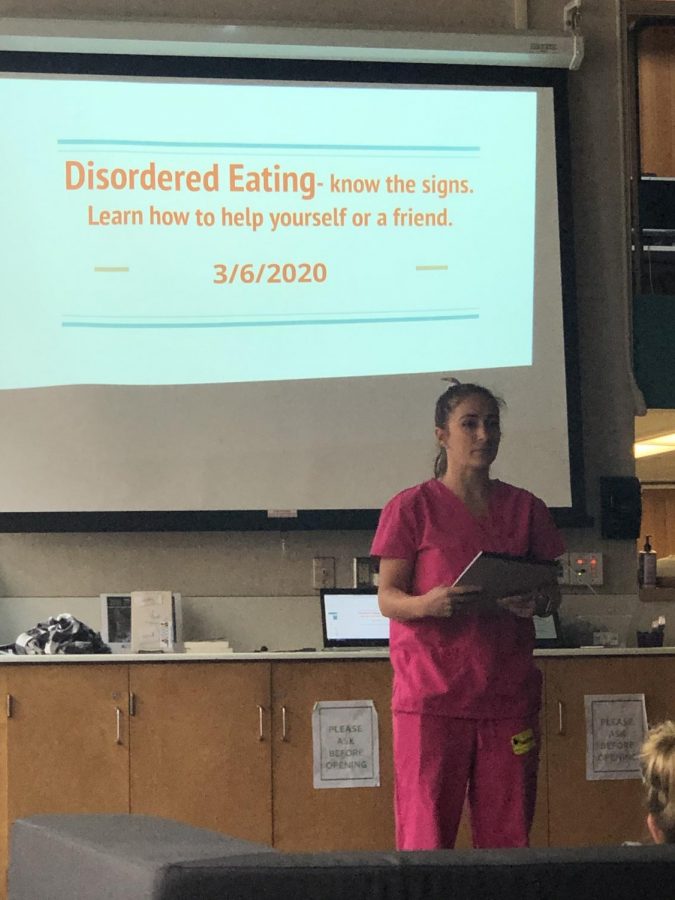Wellness Center Hosts Eating Disorder Presentation
March 26, 2020
March 6, Miramonte hosted a presentation on eating disorders in the Wellness Center to spread the word about National Eating Disorder Awareness Week which took place Feb. 24 to March 1. With the help of Wellness Intake Specialist Savannah Rose and Wellness Coordinator Elisa Nevarez, Stephanie Triggas, RN BSN of Sunol Hills at Oakview medical facility, presented facts on common unhealthy eating behaviors. The event was held during Academy and was available to all students.
Eating disorders are medical conditions defined by abnormal or disturbed eating habits. Triggas discussed four main types of eating disorders, including anorexia nervosa, bulimia nervosa, binge eating, and orthorexia. Anorexia is categorized by the refusal to eat food or the severe decrease in appetite in order to lose weight. Side effects often include bloating, constipation, and the loss of a regular menstrual cycle. Bulimia consists of binge eating followed by self-induced vomiting. Binge eating is the practice of eating large quantities of often unhealthy food very quickly. Periods of binging can be followed by periods of fasting which can also be detrimental to health. Finally, orthorexia is an obsession with being too healthy. Practices of someone with orthorexia may include dangerously intense workouts, excessive focus on counting calories, and strict diets that are not sustainable.
Triggas emphasized that the symptoms of these four types of disorders are largely generalizations, and even if an individual exhibits some symptoms, he or she does not necessarily have a disorder. “One thing everyone should know is that there is no ‘one size fits all’ eating disorder or way to recover,” Triggas said. However, it is important to know the signs in order to prevent disorders from getting worse. According to the presentation, the faster you catch the signs, the easier it can be to recover, similar to substance abuse cases. Triggas explained that common signs of eating disorders may include, but are not limited to, using dieting pills, wearing baggy clothes, skipping meals, eating in secret, chewing food but not swallowing, talking to avoid eating in social settings, and counting calories. “The presentation taught me how serious eating disorders can be and how easy they are not to notice. It surprised me how much mentality causes eating disorders,” sophomore Lindsey Lucas said.
While there are many factors that can cause eating disorders, the three that Triggas focused on were genetic, social, and psychological. “60 to 80 percent of eating disorders are neurobiological, meaning they stem from the genetic makeup of cells,” Triggas said. Genetic factors may include not having a reward system to make eating enjoyable. According to an article titled Neuroscientifically Challenged, when exposed to a rewarding stimulus, the brain responds by increasing release of the neurotransmitter dopamine and thus the structures associated with the reward system are found along the major dopamine pathways in the brain. Some people don’t have this reward system when eating which can cause behaviors such as not wanting to eat. Additionally, psychological factors could be depression, anxiety, and perfectionism about the control of food. Finally, social factors come from the media and peer pressure of other students.
“My biggest take away was that a lot of having an eating disorder doesn’t come from choice. A lot comes from neurological biology and other outside factors. I thought that eating disorders were the majority choice and that they want to be skinnier, but the presentation brought to my attention how much of it is not a choice,” sophomore Ellis Bergquist said.
About a dozen students attended the presentation. “I overheard some students in my class saying very insensitive and incorrect things about eating disorders. That just goes to show how much our school could benefit from opportunities like this to learn more about eating conditions,” senior Lauren Owens said. “There are a lot of misconceptions about eating disorders, such as only skinny people or girls have them,” Triggas said.
During the presentation, there was an activity in which Triggas asked students to write the phrase ‘I am writing with my non-dominant hand’ with their non-dominant hand. After that, she asked students to write: “I am writing quickly with my non-dominant hand” as she ran around and yelled at the students to write faster. After the activity, she told students they had to take notes with their non-dominant hand. The reaction amongst the students was that this activity would be stressful, unproductive, useless, and uncomfortable. Triggas used this activity to describe how it can feel for someone who is recovering from an eating disorder. It is not easy, it is not comfortable, and it does not feel possible. “The warmup was extremely hard. She said telling us to write with our non-dominant hand was like telling someone with an eating disorder to ‘just eat’. The activity made me sympathize more for those that have an eating disorder and helped me understand what they are going through,” Bergquist said.
“If you think you might have an eating disorder, my advice is to talk to someone. Looking for help is the best first step you can take,” Triggas said. In addition to reaching out to a trusted friend or family member, other options available to students looking for help include the National Eating Disorder Association website and questionnaire. “(Having an eating disorder) is sometimes not a choice and people might not want to admit they have one or might not even realize they have one. You should try to know the signs and know how to help a friend that might be struggling with one,” Bergquist said.
In order to spread body positivity on campus, Triggas recommends “body-positive Instagram accounts, changing the narrative and the kind of conversations students have with each other, and placing value on the inside of an individual, rather than the outside.”









